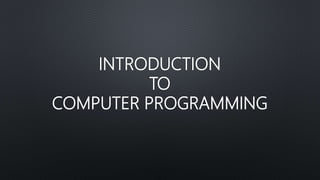
10 lesson7
- 2. What is a computer program? - is a series of instructions written to perform a specific task on a computer. A computer needs a program to work. - the program has an executable form that the computer can use directly to perform instructions. What is programming? - the art or process and science of creating/writing programs. - the process done by programmers to instruct a computer on how to do a task.
- 3. What is programming? - the process of planning and designing solutions for a particular problem and then writing the code using a programming language. What is a programming language? - is a tool that allows programmers to write commands or programs that can easily be understood by a person and translated into codes that are machine-readable - a form of communication that programmers use to develop applications, scripts or other set of instructions for a computer to execute
- 4. CLASSIFICATION OF PROGRAMMING LANGUAGE 1. Machine Language • the only language that a computer can understand • difficult to understand because it only understands the system, 0s and 1s are known as the “machine code: • Lowest level programming language
- 5. CLASSIFICATION OF PROGRAMMING LANGUAGE 2. Assembly Language • more advanced than the machine language • Uses mnemonics in place of 0s and 1s to simplify the programmer’s way of creating programs Mnemonics – are memory aids. Instead of using numbers, programmers began using English-like abbreviations such as mov for move, mul for a multiplication operation, add for an addition operation and so on.
- 6. CLASSIFICATION OF PROGRAMMING LANGUAGE Example: Machine Language Assembly Language 10110000 01100001 Mov al. 01ah Assembly Language is easier to understand, it is incomprehensible to computers. Thus it needs another called an ASSEMBLER which translated assembly language statements into the target computer machine code.
- 7. CLASSIFICATION OF PROGRAMMING LANGUAGE Programming in machine and assembly languages are too tedious and require highly trained programmers. 3. High-Level Language • used to speed up programming process • were developed to allow programmers to use English commands to carry out instructions Examples: BASIC, COBOL, Pascal, FORTRAN, C, etc.
- 8. CLASSIFICATION OF PROGRAMMING LANGUAGE These languages require separate programs like an assembler translate instructions to machine code. The translators used were an interpreter or compiler. Interpreter – translates high-level instructions into machine code, line by line as the program is running. Compiler – translates the entire program into machine code before running the program
- 9. CLASSIFICATION OF PROGRAMMING LANGUAGE Example: Begin Input “Enter your name:” fname$ Input “Enter your birthyear:” byear$ Input “Enter the current year:” cyear$ Age$ = cyear$ - byear$ Print fnames$,”,your age now is “,Age$ End
- 10. CLASSIFICATION OF PROGRAMMING LANGUAGE Most of these languages are procedure-oriented. Procedure-oriented means that the instructions must be properly sequenced in order for the computer to process the tasks correctly. 4. Object-Oriented/Event-Driven Programming Languages • GUI environment programs, user-friendly but demanded more complex programming tools.
- 11. CLASSIFICATION OF PROGRAMMING LANGUAGE • the emphasis of creating a program was on the objects include in the user interface like buttons and scrollbars. Example: Visual Basic, Delphi, Visual C++, PROLOG, and Smalltalk Examples of event driven – Microsoft Office applications such MS Word, MS Excel
- 12. Program Development Process PLANNING CODING TESTING & DEBUGGING DOCUMENTATION MAINTENANCE
